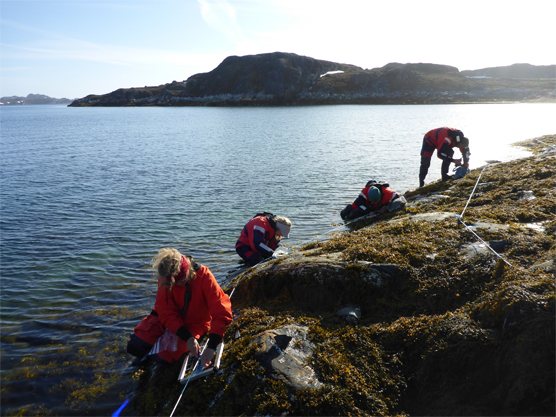Press release 2018-03-06 at 9:08
Press release of the Finnish Environment Institute SYKE and Aarhus University
Burning of floating and stranded oil was successfully tested last summer in Greenland by Aarhus University, Greenland Oil Spill Response A/S, Lamor Corporation Ab and DESMI A/S. The experiments included two novelties: the coastal in-situ burning and the collection of burnt residues from water. The pilot scale experiments and other results of the GRACE project coordinated by the Finnish Environment Institute SYKE are presented in the international seminar on 7–8 March.
The experiments were conducted in an enclosed arctic water basin in Greenland in July 2017. Approval for the experiments was given by the Greenland authorities.
During an in situ burning operation, the oil is ignited on the sea surface. The volume of oil reduces substantially through burning. The method has potential as an oil spill response in remote arctic areas, but very few pilot experiments have been performed, especially with the heavier bunker oils. Furthermore, the in situ burning on the coast has never been tested before. More information on the efficiency and the environmental impacts of in situ burning are needed.
The main environmental concerns about in situ burning are the smother and toxicity of the burnt residues and effects of the air emissions. When the oil is burnt on the coast, also the heat effects should be considered.

Baseline study of shoreline before experiments in Greenland, July 2017. © Photo: Ole Geertz-Hansen
The experiments carried out in Greenland in July included offshore and coastal in situ burning experiments of a heavy bunker fuel oil and a crude oil. To mitigate the environmental effects of the tests, the experiments were performed behind a barrier boom. The experiments gave very valuable lessons and hands-on experience in the coordination and completion of a real time in situ burning operation. Clear understanding of the responsibilities and commando lines are key elements in this kind of operation.
Offshore in situ burning of heavy bunker oil (IFO 180) was very efficient; the oil was easy ignitable and produced a limited amount of residues in the sea water. Most of the residues could be collected by trawling.
The test of the novel methodology, coastal in situ burning, was very successful. The oil was efficiently burned on the rocky coast covered by seaweed, and the operation was simpler than offshore in situ burning.
Immediately after the experiments, the DESMI A/S trawl and Lamor Corporation Ab mechanical oil spill response unit were tested in recovering the residues. The results will be used in the further development of the residue collection equipment.
Environmental effects and monitoring
The environmental side effects of the in situ burning of oil are monitored on macroalgae, winkles and blue mussels. The residues collected from the water are at the present under process for chemical characterization, as well as ecotoxicological analysis. Potential long-term environmental effects will be revealed after monitoring in summer 2018. Environmental effects of air emissions will be addressed in another project by Aarhus University.
The GRACE project – Integrated oil spill response actions and their environmental effects – started in March 2016 and focuses on developing, comparing and evaluating the effectiveness and environmental effects on different oil spill response methods in cold climate. Furthermore, the project develops real-time observation of underwater oil spills and a strategic tool for evaluation and choosing oil response methods. The project is funded by EU Horizon 2020-program.
GRACE and several other international projects present their results and best practices in the seminar Oil Spills in Arctic Areas in the City of Oulu on 7–8 March. The GRACE presentation will be held on Thursday 8.3. at 13:00.
Parallel to the seminar multipurpose vessels and an aircraft are having oil spill response exercise off the coast of Oulu City in Northern Finland. The vessels are testing mechanical brush skimmers that are suited for oil spill response in ice conditions.
Watch the video: Combat of oil spills in Arctic waters - in situ burning experiments, Greenland
You can follow the oil spill response exercise in real time video streaming. Live broadcast from MOSPA2018 will start 7.3. at 09.00 Finnish time (07.00 UTC).
More information:
Work package leader Kim Gustavson, Department of Bioscience, Aarhus University, Roskilde, Denmark, tel +45 22 640 945, kig@bios.au.dk
AU project coordinator Susse Wegeberg, Department of Bioscience, Aarhus University, Roskilde, Denmark, sw@bios.au.dk, tel. +45 30 183 118
Director Lonnie Bogø Wilms, Greenland Oil Spill Response, Nuuk, Greenland, tel. +299 560 245, lbw@gosr.gl
GRACE project coordinator Kirsten Jørgensen, Finnish Environment Institute SYKE, tel. +358 295 251 245, kirsten.jorgensen@ymparisto.fi
Communication Specialist Katri Haatainen, tel. +358 295 251 135, Finnish Environment Institute SYKE, firstname.lastname@ymparisto.fi
Project web pages:www.grace-oil-project.eu
Photo for media use:
Baseline study of shoreline before experiments in GRACE project. July 2017 Greenland. Photo: Ole Geertz-Hansen (n. 2 MB)